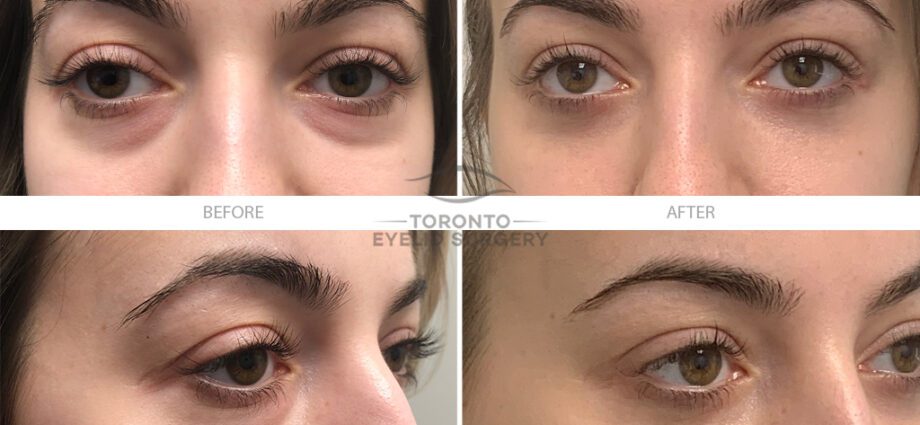Contents
Surgery of eyelids, bags and dark circles: management of blepharoplasty
Eyelid surgery is one of the most commonly performed cosmetic operations. In 2016, nearly 29 blepharoplasties were performed in France, and this figure continues to increase. What does it consist of? What are the postoperative consequences? The answers of Dr. Éléonore Cohen, cosmetic surgeon in Paris.
Definition of blepharoplasty
Blepharoplasty is cosmetic surgery aimed at correcting drooping eyelid problems, which become more pronounced with age. “This small operation aims to lighten the look, by removing the elements that appear over time: muscle relaxation and fatty hernia, bags of the lower eyelid, but also of the upper eyelid at the level of the inner corner of the eye” explains the Dr Cohen.
Preoperative consultation for eyelid surgery
As with any cosmetic surgery operation, the preoperative consultation is essential. It allows the patient to express his requests and expectations, and the surgeon to check whether the operation is justified. “We assess the excess skin with a claw forceps, which can range from a few millimeters to more than one centimeter” specifies the surgeon.
During this consultation, the surgeon will also ask for an ophthalmological assessment, in order to check that there is no contraindication or significant dry eye, which would require prior treatment.
As with any cosmetic surgery operation, a period of at least 15 days between the preoperative consultation and the intervention, must be respected, in order to guarantee a period of reflection for the patient.
Preoperative recommendations
Tobacco having harmful effects on healing, it is strongly recommended to stop smoking – or at least to limit tobacco to 5 cigarettes per day maximum – for a month before the operation and 15 days after.
In addition, no medicine containing aspirin can be taken in the 10 days preceding the operation.
The different types of blepharoplasty
There are several types of blepharoplasty, depending on the eyelid operated on and the profile of the patient.
Blepharoplasty of the upper eyelid
It consists of removing excess skin, recreating a fold, and lightening the look by freeing the inner corner of the upper eyelid. “The incision is made in the fold and the thread is hidden under the skin. It is the intradermal suture technique that makes the scar very discreet, ”describes Dr. Cohen. The threads are then removed after a week.
Blepharoplasty of the lower eyelid
This time it is about removing excess fat, or even skin, located on the lower eyelid of the eye, namely the famous bags under the eyes.
Depending on the clinical examination, which must be performed by the surgeon, two types of techniques may be proposed:
In case of excess skin: the goal is to remove fat and lift the skin. The surgeon will make the incision under the eyelashes. “The scar melts under the ciliary edge and does not persist beyond a few weeks,” explains Dr. Cohen.
In the absence of excess skin: which is generally the case in younger subjects, the doctor goes through the inside of the eyelid. This is called the conjunctival pathway. “The scar is then completely invisible because it is hidden in the internal lining of the eyelid” specifies the surgeon.
The operation lasts about 30 to 45 minutes on an outpatient basis in the office, or in the clinic if the patient wants to be asleep. “In the vast majority of cases, the patient prefers local anesthesia, to which can be added a slight intravenous sedation” explains Éléonore Cohen. However, it happens that some patients prefer a general anesthesia in the clinic, they will then have to meet the anesthesiologist at the latest 48 hours before the operation.
The post operative
Blepharoplasty is a very painless operation, but the postoperative consequences should not be minimized, especially for the operation of the lower eyelids.
For upper eyelid blepharoplasty: edema and bruising may persist for a week and then subside.
In the case of the lower eyelids: “the consequences are more difficult and it is important to inform the patient. The edema is more substantial and extends to the cheekbones. Bruises fall down to the lower cheeks, and persist for a good ten days, ”insists the surgeon.
Possible treatments
Anti-edematous drugs can be offered, as a cream such as Hemoclar®, or as an Extranase® tablet. A healing cream based on vitamin A and arnica are also recommended postoperatively.
“The patient will also have to rinse his eyes with physiological serum several times a day to clean his scars with a soft compress” describes the specialist.
The threads are removed after a week, and most of the time the patient can resume normal activities.
Risks and contraindications
It is important to treat dry eye problems beforehand, which can be the cause of postoperative conjunctivitis, hence the value of an ophthalmologist check-up before the operation.
The operative risks are very low and the complications very rare, they are linked to the anesthesia and the surgical act. Recourse to a qualified plastic surgeon ensures that he has the necessary skills to avoid these complications, or at least to treat them effectively.
Price and reimbursement of blepharoplasty
The price of blepharoplasty varies depending on the eyelids to be corrected, as well as the practitioner, their intervention structure and their region. It can range from 1500 to 2800 euros for the two upper eyelids, from 2000 to 2600 euros for the lower eyelids and from 3000 to 4000 euros for the 4 eyelids.
Considered non-restorative plastic surgery, blepharoplasty is very rarely covered by social security. However, it may be partially reimbursed by certain mutuals.










